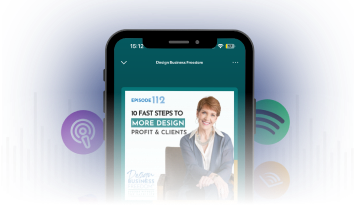Prioritizing Profit In Design
It’s easy to get caught up in a whirlwind of design tasks and activities. However, not all tasks are created equal—some contribute significantly to your profit, while others don’t. Prioritizing profit in design requires you to focus on high-value, profit-driving activities that ensure your business thrives. Here’s how you can identify the tasks that truly matter for your bottom line.
1. Understand the Difference Between High-Dollar and Low-Dollar Activities
The first step in prioritizing profit in design is understanding the difference between high-dollar and low-dollar activities. High-dollar tasks are those that directly contribute to generating revenue and growing your business. These might include client outreach, strategic partnerships, and high-level creative work. On the other hand, low-dollar tasks, while necessary, don’t directly drive profit. These include administrative tasks, routine social media posts, and basic project management.
Focus your energy on high-dollar activities and delegate or outsource low-dollar tasks. By doing so, you can maximize your time and ensure that you’re spending it on activities that have the most significant impact on your business’s success.
2. Prioritize Marketing and Lead Generation

When it comes to marketing and lead generation, not all efforts yield the same return. Categorize social media engagement, such as direct messages (DMs) and comments, as high-dollar activities because they foster direct connections with potential clients. In contrast, routine social media posts are low-dollar tasks that can be easily outsourced.
High-dollar marketing activities also include attending live events, networking with potential clients, and building profit partnerships with other professionals like builders, architects, and realtors. These relationships can lead to direct referrals and new business opportunities, making them worth your time and attention.
3. Focus on Sales and Offers
Within the sales process, certain activities have a higher dollar value than others. For instance, the second part of the Design Discovery process is a high-dollar activity that requires your expertise. This is where you conduct in-home consultations and deliver detailed reports. In contrast, the initial Zoom consultations can be handled by a team member, making them low-dollar tasks.
Similarly, preparing proposals, agreements, and negotiating contracts are high-dollar activities that should be your priority. These tasks are crucial for closing deals and bringing money into your business, so they deserve your full attention when prioritizing profit in design.
4. Get Comfortable with Money Conversations
Talking about money can be uncomfortable for many designers, but it’s essential for prioritizing profit in design. The more comfortable you become with discussing money—whether it’s about fees, investments, or payments—the more successful you’ll be in your business. Money is a necessary part of doing business, and the energy you hold around it can significantly impact your financial success.
Make it a habit to have regular, straightforward conversations about money with your clients. This transparency not only builds trust but also ensures that everyone is on the same page regarding the financial aspects of the project.
5. Dollarize Your Day
One of the most powerful exercises that I recommend is “dollarizing” your day. This means evaluating every task on your calendar and assigning it a dollar value based on its contribution to your profit. You can use a scale, much like a restaurant might $ – $$$$$. Tasks that have a high impact on your revenue should be prioritized, while low-impact tasks should be delegated or eliminated.
By dollarizing your day, you gain a clear understanding of where your time is best spent and can make informed decisions about how to structure your workweek. This practice ensures that you’re always focusing on activities that drive your business forward and is a key element in prioritizing profit in design.
Key Takeaways
Prioritizing profit in your design business requires a strategic approach to how you spend your time and energy. By focusing on high-dollar activities, delegating low-dollar tasks, and becoming comfortable with money conversations, you can ensure that your business is on a path to growth and success.Remember, it’s not just about working hard—it’s about working smart and making sure every action you take is aligned with your financial goals.
When you’re ready to increase your interior design business profits, work exclusively with ideal clients, and enjoy the time and resources for your extraordinary life, explore your coaching options. We’ve got your back in the business of design and the business of home.





